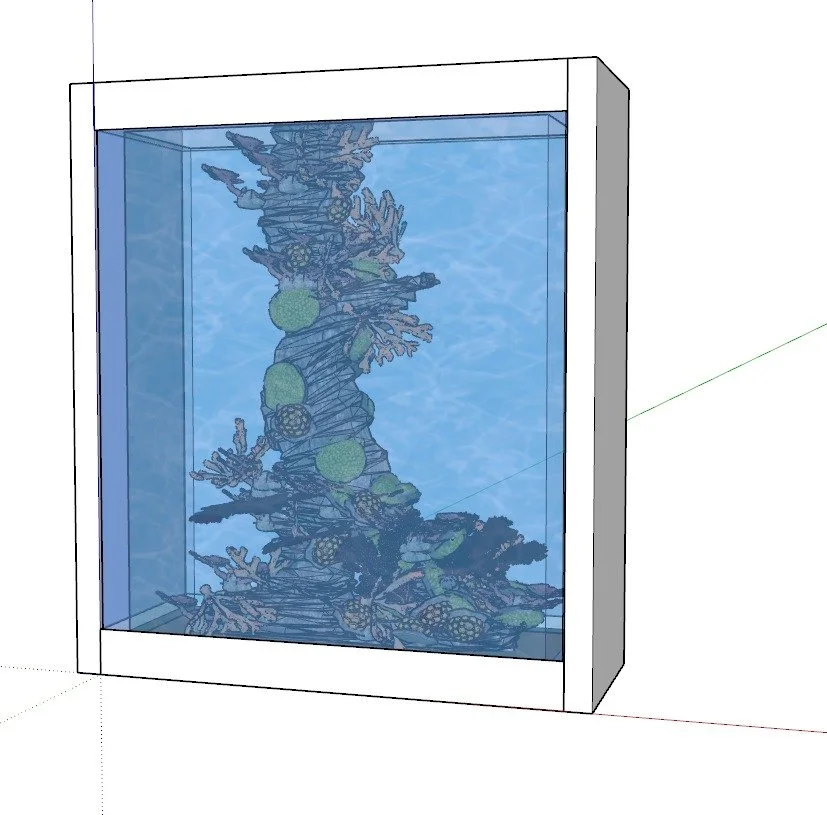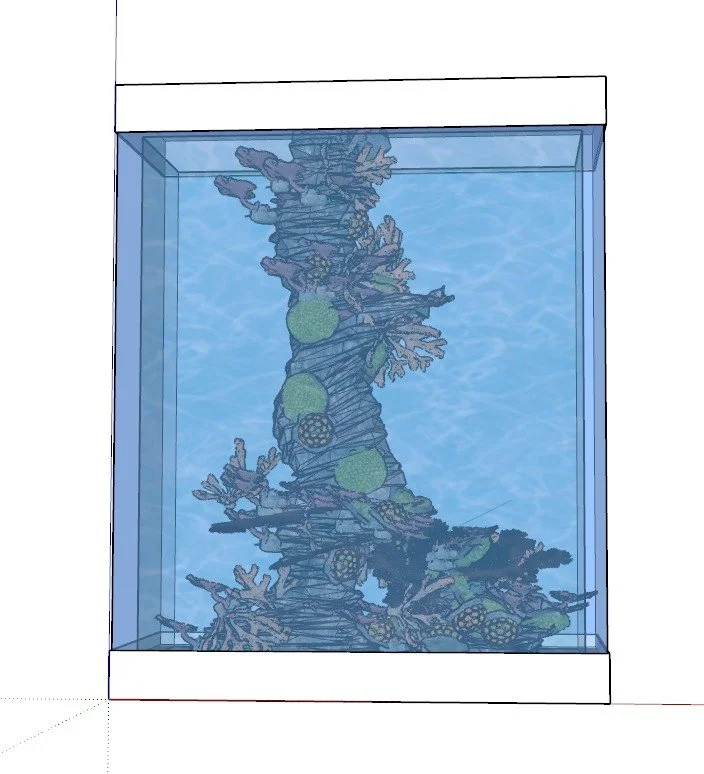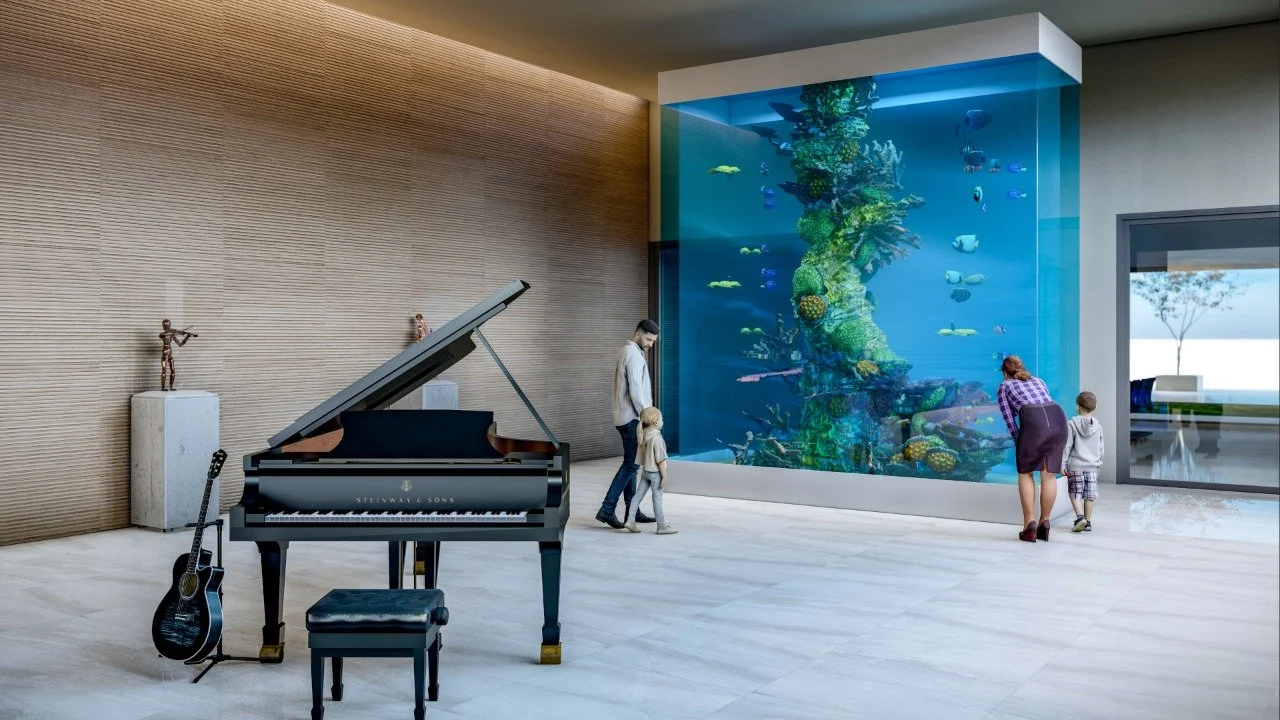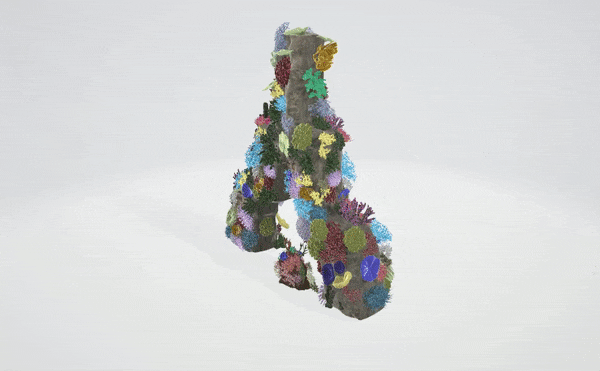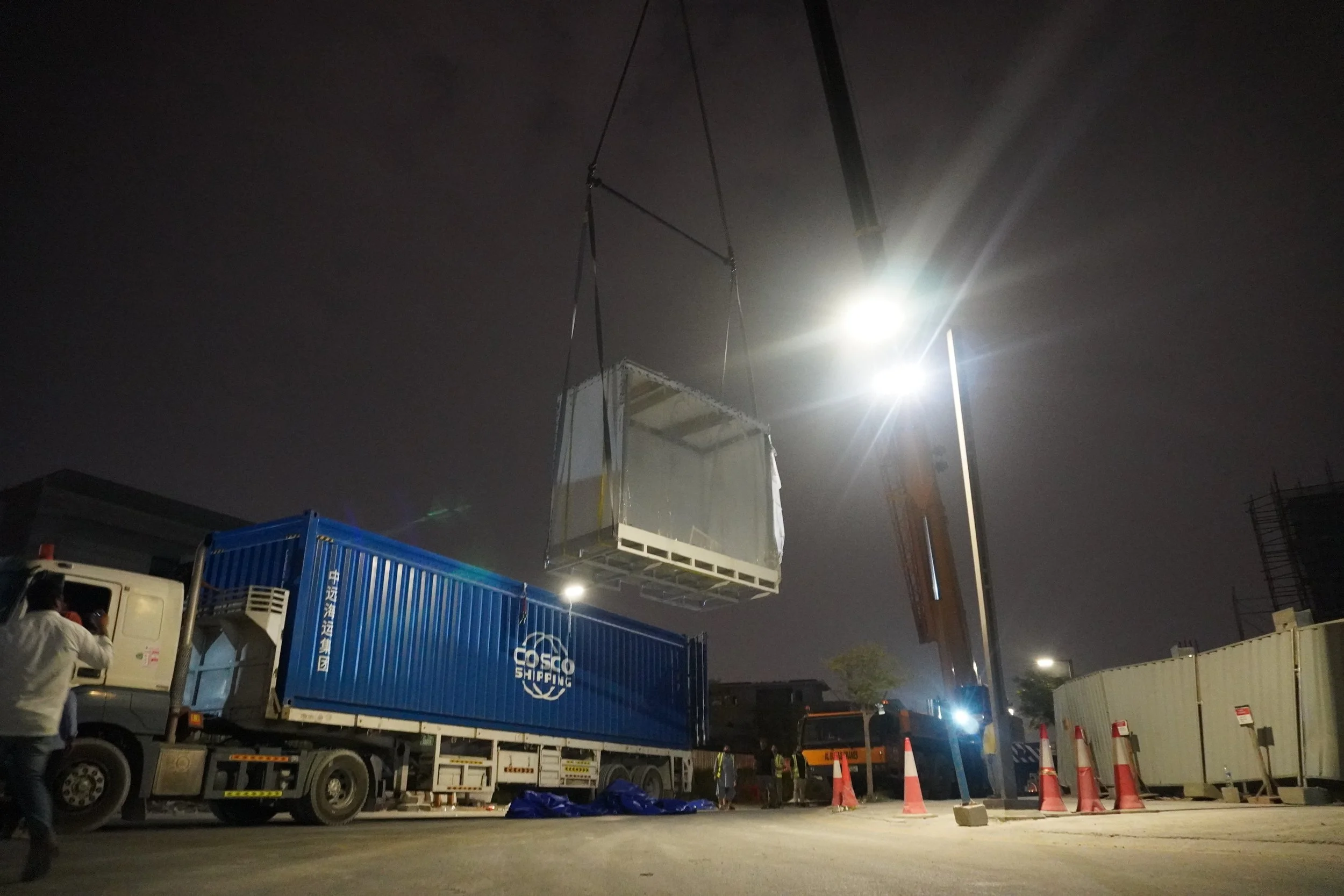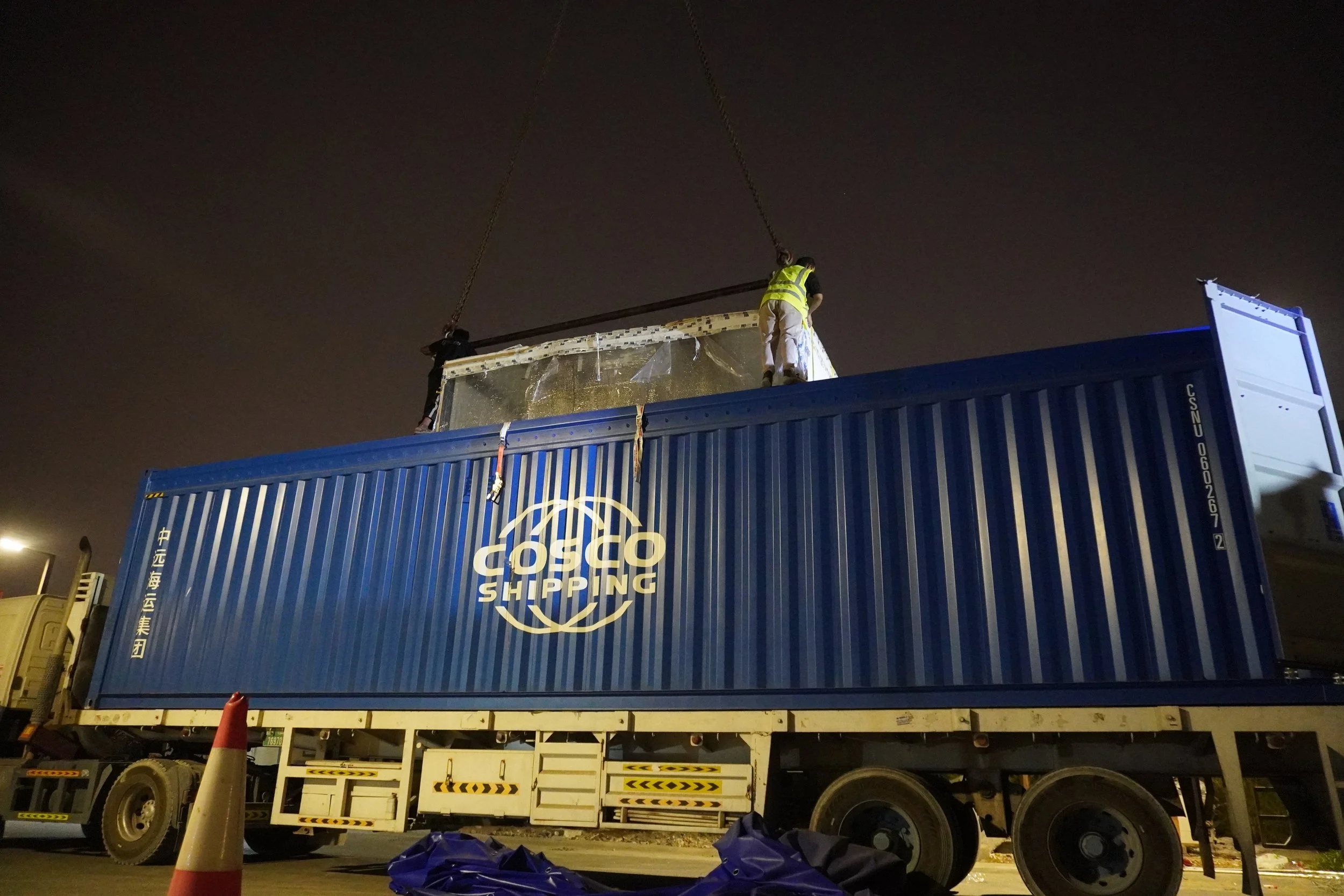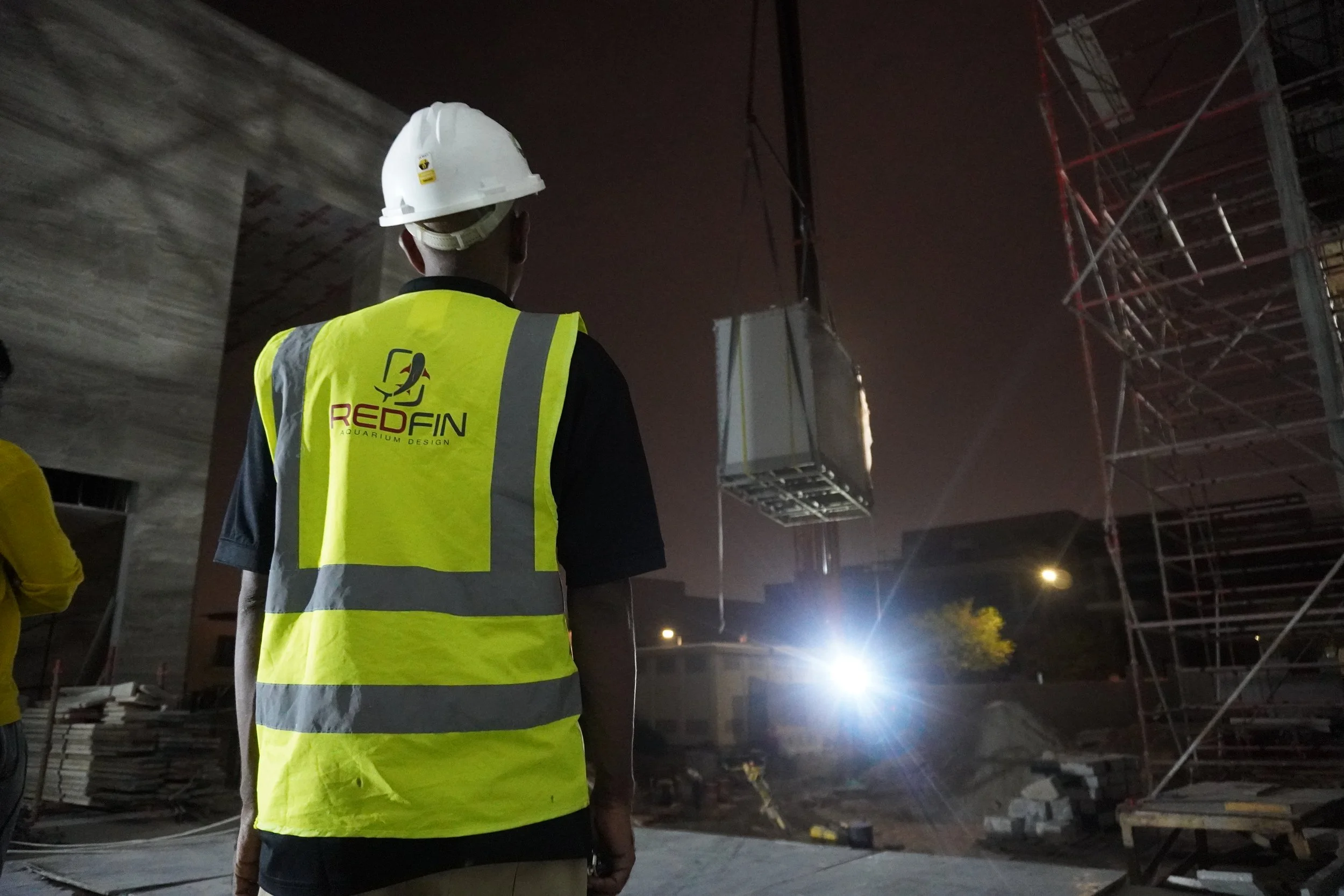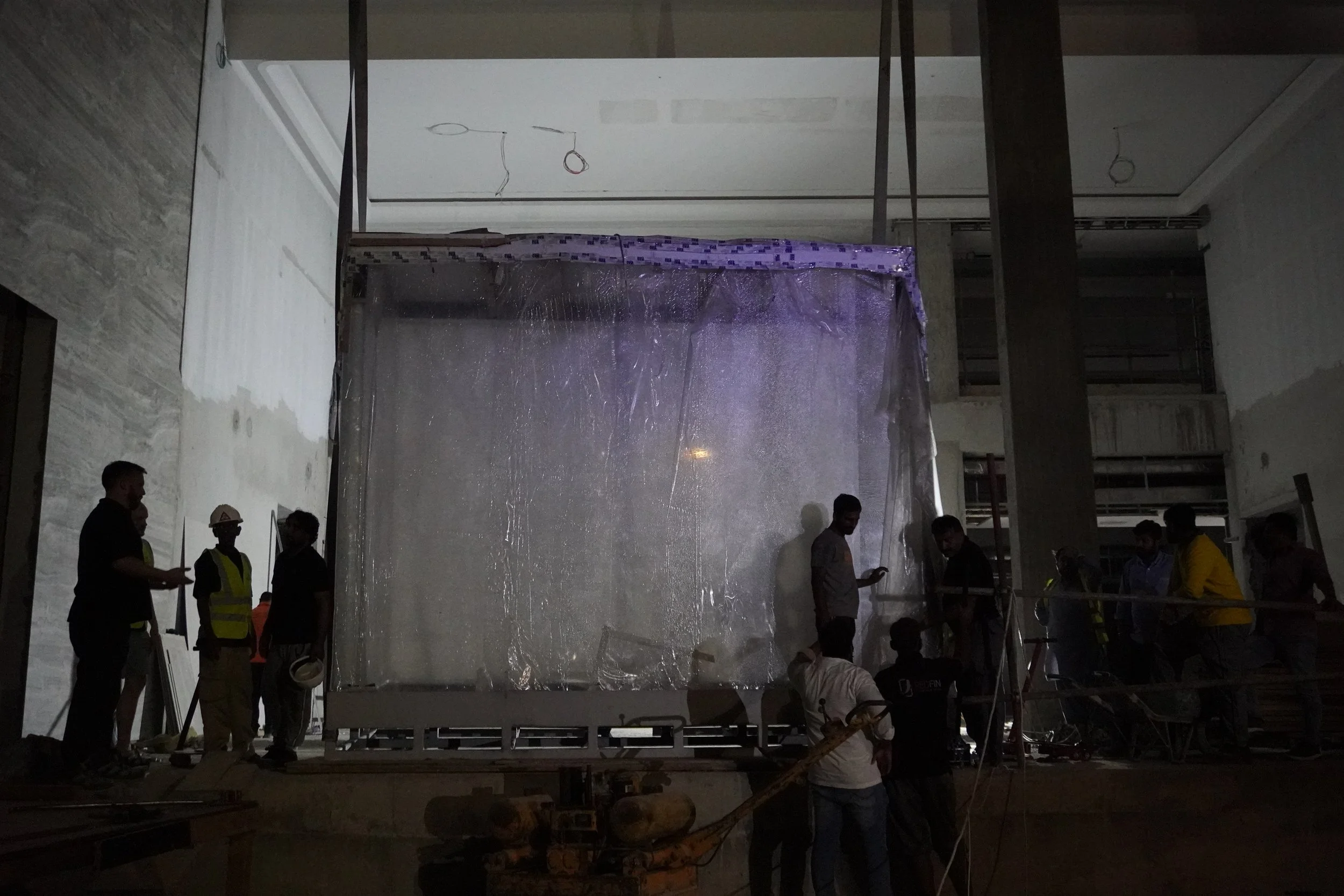Design & Build of a 10,000 Litre, All Sides Viewable, Residential aquarium
Concept Development
RedFin Aquarium Design was commissioned to create an extra-large, floor-to-ceiling saltwater aquarium in the center of a villa under construction in Dubai. The client wanted a centerpiece visible from all four sides, with top access from the floor above.
After considering various options, the client opted for a saltwater aquarium. Their decision was driven by a desire to showcase a vibrant, colorful, and exciting array of fish that would captivate both the family and their children. Saltwater fish were chosen due to the wide variety available and their distinct personalities.
The placement of the aquarium required careful consideration of both aesthetic and practical factors. The client wanted to minimize disruptions from the aquarium maintenance team in their living area. To achieve this, the filtration equipment was strategically located on the floor below the tank, with access provided from the car park. This setup ensured that maintenance could be conducted without interfering with the main living space. Additionally, access to the top of the tank for cleaning and feeding the fish was made possible from the floor above the aquarium.
The final design was also influenced by technical constraints, particularly in terms of access and floor loading. The house was designed and built with the aquarium in mind from the very beginning. Structural engineering considerations included the significant weight of the aquarium, and access routes were pre-planned to facilitate the installation of such a large feature.
Technical Design
The technical design of the aquarium was a critical aspect of the project, requiring careful analysis and the integration of advanced technology to ensure both safety and functionality. RedFin began by conducting a thorough structural engineering analysis using finite element analysis (FEA) software. This allowed the team to closely examine the tank's drawings and models, focusing on areas of potential stress. Particular attention was given to the acrylic panels and the connections where they were bonded together. The goal was to ensure that these panels would not deflect under the significant weight of the water beyond acceptable limits and that the corners, where the panels were connected, could withstand the stress without fracturing.
Filtration & Water Quality:
Filtration was another key consideration in the design. RedFin implemented a combination of custom-made and off-the-shelf aquarium support equipment to create an efficient and reliable filtration system. The system included an Oceanyx protein skimmer, a custom all-acrylic sump with particle and biological filtration, an Oceanyx UV sterilizer, a Badu Prime main return pump, a custom ozone generator, an Oceanyx water chiller, and an Apex control computer. Each component was selected for its ability to maintain optimal water quality and ensure the long-term health of the aquarium's inhabitants.
Lighting
The lighting system was also carefully chosen to enhance the aquarium environment. RedFin opted for a specialized system from Orphek, featuring six Amazonas 960 iCon LED lights. Each of these lights draws 320 watts of power when operating at full capacity, with the LED colors specifically selected to replicate natural sunlight. The emphasis was on the blue and UV spectrum, which penetrate saltwater most effectively, creating an environment that closely mimics natural conditions. The lights are fully controllable, allowing for the recreation of day, night, and moonlight cycles, which are crucial for the well-being of the aquarium's occupants.
Theming/Coral Sculpture Design
To ensure the interior aesthetics of the aquarium met the client’s expectations, RedFin worked with Bio-Theme to 3D model the rock sculptures and coral decorations. This process provided the client with detailed 3D and 2D visualizations, offering a clear representation of the aquarium’s interior before the start of manufacturing. This allowed for adjustments and ensured that the final design aligned perfectly with the client’s vision.
Overall, the technical design of the aquarium was a carefully orchestrated process that combined advanced engineering analysis with state-of-the-art equipment and thoughtful design, resulting in a stunning and functional centerpiece for the villa.
Manufacturing
The manufacturing process for the aquarium was a complex and meticulously managed operation, requiring significant time and attention to detail. The most time-consuming aspect was the construction of the acrylic tank, which was crafted by an Italian manufacturer known for their expertise in acrylic fabrication. The tank was made using 120mm thick acrylic panels that were bonded together with raw acrylic material. This method ensured that the bonds were not only incredibly strong, eliminating any potential weakness that could lead to fractures under pressure, but also perfectly clear. The absence of visible join lines gave the aquarium a sleek, modern appearance.
Component Management
The entire aquarium system was composed of over 50 major elements and over 500 individual parts. These parts were sourced from various locations around the world, including Italy, Germany, the UAE, the United Kingdom, and China. This global supply chain required careful coordination to ensure that all components arrived on time and met the project's stringent quality standards.
Quality Control
Throughout the manufacturing process, RedFin employed a dedicated quality control (QC) management team to oversee the production of every component. These specialists conducted regular inspections and monitored each stage of construction to identify any potential issues early on. When issues were detected, they were swiftly addressed, either through quick rectifications or by remanufacturing the affected parts. This proactive approach ensured that no quality concerns lingered until the final pre-shipping inspection, thus preventing delays or complications upon delivery. The rigorous QC process was crucial in guaranteeing that the finished aquarium met the client’s expectations and was free from defects upon installation.
Theming Manufacture
The aquarium theming manufacture process began with transforming digital 3D models of rockwork and corals into realistic, durable sculptures. A large CNC milling machine carved the basic rock shapes from foam, which were then used to create molds that matched the original 3D models precisely. Each mold was lined with a layer of fiberglass-reinforced plastic (FRP), providing a sturdy skeleton for the rock formations. FRP was chosen for its durability in saltwater environments and its non-toxic nature, ensuring it wouldn’t degrade or release any harmful compounds that could impact the fish.
To mimic the appearance of natural reef rock, a coat of epoxy was applied to the rock surfaces, giving them a lifelike texture. Artists then painted the rockwork in various shades, simulating the natural growth of marine algae, with colors ranging from vibrant greens to deep purples.
The final step was the addition of artificial corals, crafted from tough rubber materials to withstand the frequent cleaning done by divers. This method allowed for realistic, resilient decorations that enhance the underwater habitat while standing up to regular maintenance. The result is a stunning and safe underwater landscape, designed to captivate visitors and support marine life.
Installation
For the Aquarium Installation project, the setup took about a month from start to finish, including the installation of the tank, filtration system, and themed decorations. Once everything was in place, an additional week was dedicated to testing and commissioning, ensuring the setup was fully operational.
The installation involved a coordinated effort from the RedFin team. Three skilled members handled the plumbing and electrical work, while a larger team of about 18 workers assisted with moving and positioning the heavy equipment, including the tank itself, the sump, skimmer, and decorative themed elements.
The installation process included several complex steps. The massive tank had to be lifted and carefully maneuvered through the construction site using heavy-duty rollers. Filtration equipment needed precise positioning, followed by intricate plumbing and electrical work. Finally, the artificial rock and coral decorations were placed inside the tank, creating an engaging underwater landscape.
However, the installation wasn't without its challenges. The construction site was busy, with multiple contractors on tight schedules. Coordinating with them added complexity to the project. Additionally, arranging a crane large enough to lift the 6,500 kg tank from its container on the road and into the building presented a logistical hurdle, requiring careful planning and timing to ensure everything went smoothly.
Livestock and Maintenance
The livestock and maintenance process for this aquarium was meticulously planned to ensure a healthy, vibrant environment for the fish and other inhabitants. Building the tank's bacterial ecosystem started with a "cycling" period, essential for breaking down fish waste and uneaten food. This process involved adding ammonium chloride and specific bacteria strains to speed up bacterial growth, making the water safe for fish. Although the aquarium could be ready in as little as a week, we allowed an extra three weeks to settle, with fish introduced about four weeks after filling the tank.
For the livestock selection, the client envisioned a display filled with large, colorful fish, complemented by benthic sharks and stingrays. RedFin’s marine biologists carefully selected species that would coexist harmoniously, minimizing aggression and predation. Some of the tank's standout residents include blue spot stingrays, large wrasse species, colorful Sohal, Achilles, and purple tangs, bamboo and coral cat sharks, and majestic moray eels.
The fish are fed a varied diet tailored to their needs. Larger predatory fish, like eels and rays, enjoy whole shrimp and small fish such as mackerel and sardines. Other fish are given pellet foods and strips of dried seaweed. Automated feeders distribute small portions throughout the day in different areas of the tank, promoting natural feeding behaviors.
Maintenance of the aquarium is thorough and consistent. Divers enter the tank three times a week to clean the acrylic walls and scrub the artificial rock and coral structures. A robust filtration system helps control algae growth and keeps the water clear. Particle filtration is managed with 100-micron filter socks, which are regularly replaced and pressure-washed. The protein skimmer features a self-cleaning head, and around 10% of the tank's water is replaced monthly with high-quality Red Sea salt to maintain optimal conditions.
This careful balance of cycling, stocking, feeding, and maintenance keeps the aquarium a stunning and healthy showcase of marine life.
Summary
The 10,000-litre, all-sides viewable residential aquarium is a technically advanced, visually striking centerpiece, combining structural engineering, cutting-edge filtration, realistic theming, and sustainable marine life management.
Location: Dubai, UAE
Dimensions: Floor-to-ceiling, viewable from all four sides
Status: Installed and fully operational
Total Volume: 10,000 litres





